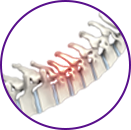Degenerative Spine

Degenerative spinal conditions are a group of disorders that causes loss of normal structure and function of the spine. These disorders may be caused due to ageing, infection, tumors, muscle strains or arthritis. Degenerative joint disease is commonly known as arthritis that affects feet, fingers, hands, spine and weight-bearing joints. It is caused due to the inflammation of joints because the articular cartilage covering the bones may be damaged or worn out.
Degenerative disc disease refers to gradual deterioration of the disc between the vertebrae.
Causes
As people age, intervertebral discs lose their flexibility, elasticity and shock absorbing characteristics. Annulus fibrosis, outer fibers surrounding the disc, become brittle and is more easily torn. At the same time, nucleus pulposus, the soft gel-like substance located in the center of the disc, starts to dry out and shrink.
Symptoms
Every patient is different and it is important to realize that not everyone develops symptoms as a result of degenerative disc disease. When the condition becomes painful or symptomatic, it can cause several different symptoms due to the compression of the nerve roots. Depending on the location of degenerative disc, it could cause back pain, radiating leg pain, neck pain, and radiating arm pain.
As the discs between the intervertebral bodies start to wear out, the entire lumbar spine becomes less flexible resulting in back pain and stiffness.
Diagnosis
The diagnosis of degenerative disc disease begins with the patient’s history and a complete physical examination. Examination of the back for flexibility, range of motion and the presence of certain signs that suggest nerve roots are being affected by degenerative changes in your back. This is done by testing the strength of your muscles and your reflexes to make sure that they are still working normally.
A series of X-rays is also usually ordered and if degenerative disc disease is present, the X-rays will often show a narrowing of the spaces between the vertebral bodies, which indicates the disc has become very thin or has collapsed. Bone spurs formed around the edges of the vertebral bodies and around the edges of the facet joints in the spine can be seen on an X-ray. As a result the space available for the nerve roots starts to shrink. The nerve roots exit the spinal canal through a bony tunnel called the neural foramen and it is at this point the nerve roots are especially vulnerable to compression.
In most cases a MRI or a CT scan may be ordered to evaluate the degenerative changes, determine disc herniation and nerve root compression. A CT scan is often used to evaluate the anatomy in the spine which can show how much space is available for the nerve roots and within the neural foramina and spinal canal.
Treatment
Both surgical and nonsurgical treatment options are available for degenerative conditions and the choice depends on various factors such as the age of the patient and severity of the disease.
Nonsurgical treatment – For people with no evidence of nerve root compression or muscle weakness, conservative treatment such as medication, rest, exercise and physical therapy are typically recommended.
Surgical treatment – Surgery is offered only after conservative treatment options have failed to adequately relieve the symptoms of pain, numbness and weakness over a significant period of time. Decompression of the spinal cord accompanied by a discectomy or an anterior cervical discectomy and fusion will be performed to remove the affected disc and fuse the associated vertebrae in order to stabilize the spine in that area.
Other Conditions List
- Spine Deformities
- Degenerative Disc Disease
- Herniated Disc (Lumbar)
- Herniated Disc (Cervical)
- Cervical Stenosis
- Lumbar Stenosis
- Cervical Disc Protrusion
- Sciatica
- Scoliosis
- Spine Tumors
- Spondylolisthesis
- Ankylosing Spondylitis
- Adult Kyphosis
- Adult Kyphosis-Types and Causes
- Scheuermann’s Kyphosis
- Back Pain
- Neck Pain
- Mid-back Pain
- Sacroiliac Joint Dysfunction
- Spine Trauma
- Spinal Injuries at work
- Spinal Fractures
- Spondyloarthropathies
- Spondylolysis
- Facet Joint Arthritis
- Piriformis Syndrome
- Whiplash
- DISH (Diffuse Idiopathic Skeletal Hyperostosis)
- Burners and Stingers
- Myelopathy
- Cervical Degenerative Disorders
- Vertebral Fractures




 Menu
Menu